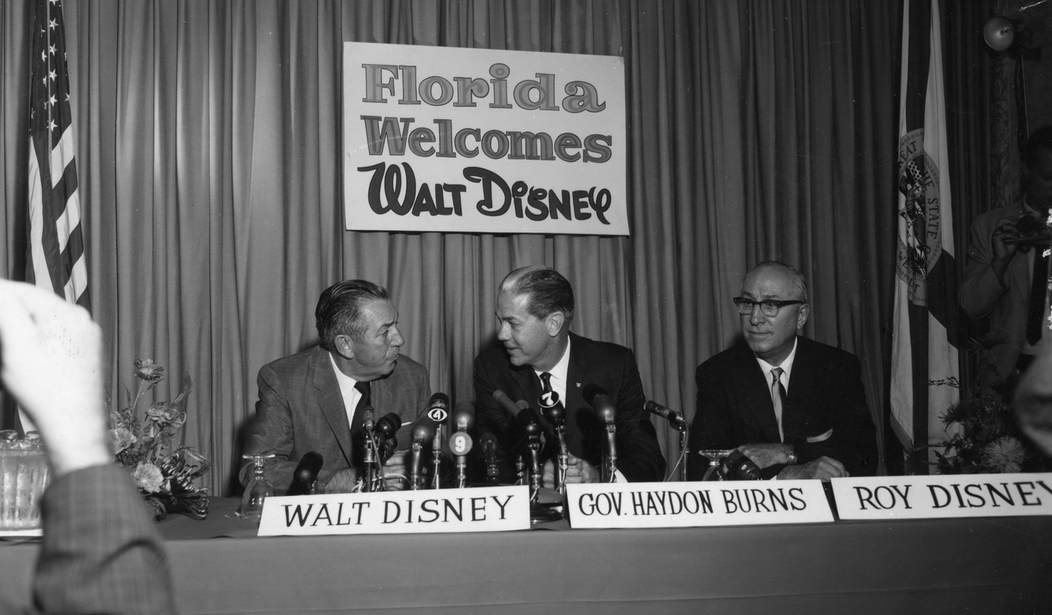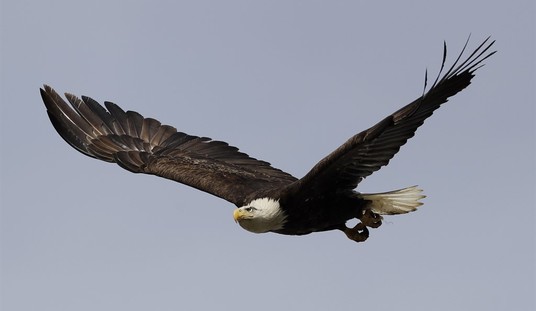We tend to think of Hollywood as a bastion of leftism, and rightly so. Books like Ron Radosh’s Red Star Over Hollywood demonstrate the deep-seated left-wing dominance of the entertainment industry. Even with the leftism prevalent in Hollywood’s Golden Age, many unabashed conservatives found success without compromising their principles, including one of the most creative minds in the business — Walt Disney.
Several biographers and writers that I’ve read have tried to declare that Walt Disney was apolitical, but I find this conclusion not to be true. Diane Disney Miller once said that her father was “kind of a strange figure” politically, and Walt admitted his own political naiveté:
A long time ago, I found out that I knew nothing whatsoever about this game of politics and since then I’ve preferred to keep silent about the entire matter rather than see my name attached to any statement that was not my own.
But plenty of people surrounding Walt Disney knew the truth: that he was conservative to his core. Ward Kimball, one of Disney’s “Nine Old Men,” said that Walt’s right-leaning politics made him uncomfortable and that politics drove a rift in their friendship in Disney’s later years. Radical writer Maurice Rapf, who worked on several Disney films, including Song of the South, said, “He was very conservative except in one particular — he was a very strong environmentalist.” However, Walt Disney’s conservatism did not manifest itself until after he had been a businessman for several years.
Walt Disney’s early exposure to politics came from his father, Elias, who was a Socialist — in particular, he followed the philosophy of J. A. Wayland. Wayland created a unique strain of Prairie Socialism in the late-19th and early-20th centuries. Daniel J. Flynn, in his book A Conservative History of the American Left, tells of how Wayland “reached Americans with the message [of Socialism] that had been heretofore explained in a German, Yiddish, or Russian accent, but never with a Bible-belt twang.”
Wayland’s newspaper, Appeal to Reason, “was folksy” and “reached the common man’s ears but irritated the intellectual’s.” Elias Disney subscribed to Appeal to Reason, and Walt remembered cutting his teeth as an artist by copying the cartoons. Walt said he “could draw cartoons of ‘Capital’ and ‘Labor’ pretty good, the big fat capitalist with the money with his foot on the neck of the laboring man with the little cap on his head.”
Elias Disney voted for Progressive William Jennings Bryan and Socialist Eugene Debs in presidential elections, despite being an entrepreneur and employer. Walt believed that he learned from his father how to be a friend of the working man, and he claimed to carry that belief even after his journey rightward.
As Walt moved into his thirties and became established in Hollywood and influenced by his brother, his politics began to change. He told one writer:
In the election of 1936, I just couldn’t go Republican. … Roy and I split. Roy went Republican and I voted for Roosevelt. By 1940 and everything that happened in the next four years, I was right back on the other bandwagon. I became a [Wendell] Willkie man. He was a great man.
However, he stopped short of endorsing Willkie that year.
By 1941, unions began to organize many employees of the Disney Studios, and they went out on strike that May. The picket line struck a blow to the company’s fragile financial state at the time, and the strike hurt Walt personally. Though the employees who led the strike, animator Art Babbitt and layout artist Dave Hilberman, had communist leanings, most of the rank-and-file strikers did not. Nevertheless, both Roy and Walt Disney laid the blame for the strike at the feet of Communism. Roy admitted that he and Walt believed that “money was never the basic problem in this thing, as much as communism [sic].”
For Walt, the strike solidified his political transformation. He contrasted his father’s socialism (“I grew up believing a lot of that…”) with his own experiences as a businessman and employer (“…but I was disillusioned”). He came to terms with this disillusionment during the strike, and he said, “A lot of my dad’s socialistic ideas began to go out the window.”
Despite his strong anti-Communism, Walt rarely discriminated personally based on politics. As Michael Barrier puts it:
He was not an aggressive Red hunter; his conservatism had a strongly personal cast. An employee’s politics were not of any particular concern to him if that employee was not challenging him as Art Babbitt and Dave Hilberman had. Some of Disney’s employees, like Ward Kimball, flourished even though it was no secret that their politics were far more liberal than his. Maurice Rapf, who worked for Disney as a live-action screenwriter for two and a half years in the middle 1940s, was an extreme example. He wrote many years later that Disney “knew very well that I was a dedicated left-winger. He may have even known that I was a Communist.”
Even though in 1944 he declared himself an “independent voter” with “allegiance to no political party,” Walt publicly endorsed Republican Thomas Dewey for president. He gave a speech in support of Dewey, and even told someone, “I’m sorry I can only give money.” He allowed a Dewey rally to take place at the studios, and he served as one of Dewey’s electors from California. That same year, his fellow members of a new conservative organization in Hollywood called the Motion Picture Alliance for the Preservation of American Ideals named him vice president.
Disney testified before the House Un-American Activities Committee as a friendly witness in October 1947. He gave an emotional testimony about the 1941 strike, recalling — to the point of breaking down in tears — how he believed the Communist influence on the strikers to be the reason they walked the picket line. He said, “I definitely feel it was a Communist group trying to take over my artists and they did take them over.”
In 1952, The Disney Studios produced a campaign spot for General Dwight D. Eisenhower, the Republican nominee for president. Eisenhower backer and cosmetics executive Jacqueline Cochran approached Roy O. Disney, who in turn talked his brother into creating an ad. Once advertising executive Rosser Reeves convinced Eisenhower to use the Disney spot along with other ads, he became the first presidential candidate to advertise on television. Eisenhower’s Democratic opponent Adlai Stevenson would not deign to appear in any ads, as he thought it was beneath the dignity of a presidential candidate.
The Disney commercial features a parade of Americans marching — to the right, naturally — to the catchy tune “We’ll Take Ike (To Washington)” while a silhouetted figure, representing Stevenson, rides a donkey leftward. Winston Hibler, voice of the True Life Adventures series, provides narration.
A longer version of the spot included a confused animated voter seeking answers to the issues of the day. A live-action actor responds, and the voter decides to support “Ike.” The Disney-produced commercial ran more often than any other campaign ad, and supposedly it was the most popular ad that year. The Disney Studios never produced another political campaign ad.
Disney and Eisenhower became friends after the campaign. Walt served in Eisenhower’s “People to People” program during his second term, and the two men occasionally vacationed at Palm Springs’s Smoke Tree resort at the same time. In 1963, Eisenhower presented Walt with the George Washington Award for “communicating the hope and aspirations of our free society to the far corners of the planet.”
The most definitive proof that authors often cite of Walt Disney’s political leanings is a check from Walt’s personal account dated Nov. 12, 1959, and made out to the Republican National Finance Committee.
That same year, Vice President Richard Nixon visited Disneyland to commemorate the opening of the Disneyland-Alweg Monorail. Nixon and Disney had become good friends by that time.
Once, Walt gave a speech in which he recalled an encounter with a policeman who gave him a ticket for making an illegal left turn. Apparently, the officer had cited Disney in the past for the same problem, and he suggested to Walt that he stick only to right turns. Walt replied that doing so would be easy because, in his own words, “I lean that way anyway.”
By 1964, Walt was firmly in the Republican camp with no apparent turning back. The golf cart he rode around the studio sported a noticeable “Vote for Goldwater” bumper sticker, and Disney talked actor George Murphy, another Republican, into running for Senate. Walt even put together a fundraising dinner for Murphy and allowed Murphy to use his likeness for a campaign mailing. Walt attended the Republican National Convention that year, where he had his picture taken with former President Eisenhower.
An incident from 1964 that reveals both Walt’s political leanings and his impish sense of humor involves his trip to Washington to receive the Presidential Medal of Freedom from Lyndon B. Johnson, who was already in the heat of the 1964 campaign against Barry Goldwater. Johnson presented the award to Disney on Sept. 14, 1964.
Walt had a small gold button stud that had the letter “G” and the number “64” (signifying Goldwater in 1964) that would be under his left lapel and clearly visible only if he flipped it. He also asked for a much larger button clearly declaring “Vote for Goldwater,” so if anyone complained about his wearing the smaller pin, Walt would flash the larger button and ask, “Would you prefer if I wear this one instead?”
People who attended the ceremony recollected that Walt, with his back to the audience, did flip the lapel to show Johnson the small pin. Johnson was already aware of Walt’s fervent support for Goldwater from a phone conversation the president had with one of his advisors eight days before the ceremony. Johnson was not happy but didn’t say anything about it, and apparently there were no repercussions. With glee, Walt later told the story to others at the Disney Studios.
In 1966, Disney backed his friend Ronald Reagan in his successful campaign for governor of California. Reagan was one of the hosts for the television coverage of Disneyland’s opening in 1955, and, like Walt, he had undergone a left-to-right conversion during the New Deal era. Of course, we know where Reagan went after he served as California’s governor.
Oddly enough, in the last year or so of his life, Disney said to his daughter Diane, “You know, I consider myself a true liberal.” Whether his statement reveals his political naïveté or whether he was thinking of the classical notion of liberalism remains a mystery.
Walt Disney may have not been the most politically educated man of his day, but I don’t believe he was truly apolitical. Rather, I think he held a set of core beliefs dear to his heart and that, by and large, they coincide with conservative, Judeo-Christian values. Over the next few weeks, I’m setting out to prove my theory. Stay tuned as I demonstrate how certain values show up throughout the Disney canon.










Join the conversation as a VIP Member